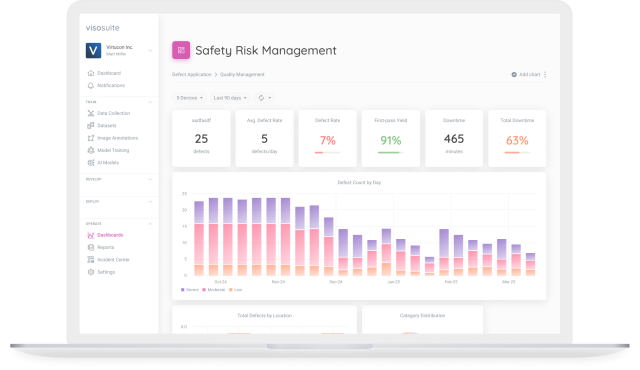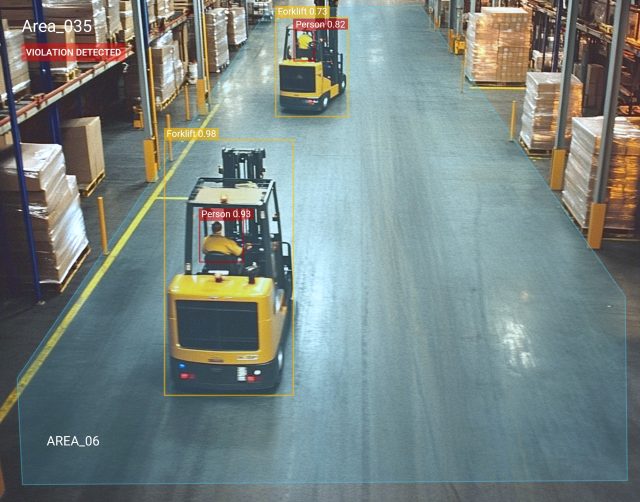The separation of pedestrian walkways and vehicle lanes is critical to maintaining safe operations. Yet, despite floor markings, posted signage, and procedural controls, incidents of forklifts or other industrial vehicles encroaching into designated walkways remain a serious and persistent risk.
While primarily putting workers in harm’s way, they also expose companies to daily liability, compliance issues, and significant financial loss. According to safety standards from regulatory agencies like OSHA, maintaining clear separation between people and machines is a non-negotiable baseline for safe facility design.
Using computer vision, manufacturers can continuously monitor walkway integrity and detect when vehicles enter zones they shouldn’t. Additionally, they can glean critical information and long-term visibility into patterns of risk from real-time alerts.
Why vehicle encroachment happens
Most facilities have well-marked pedestrian pathways and policies in place to keep vehicle traffic within designated lanes. But in practice, the demands of production, space constraints, and human error can override these safety designs.
Common scenarios that lead to vehicle encroachment include:
- Forklift operators cutting corners to save time or avoid obstacles
- Overflow storage or equipment placement that narrows vehicle lanes
- Lack of physical barriers between paths and work areas
- Inconsistent adherence to driving protocols, especially during busy shifts
- Inadequate visibility or lighting in shared zones
- Poor enforcement of right-of-way rules
These behaviors are high-risk. Even a brief incursion of a vehicle into a pedestrian zone can result in a serious injury or worse. And in the absence of real-time detection, many of these incidents go unreported or unnoticed until an audit, complaint, or accident occurs.
Monitoring walkways with computer vision
Computer vision systems can automatically monitor facility camera feeds to detect when a vehicle, such as a forklift, pallet jack, or AGV, crosses into a defined pedestrian walkway.
With Viso Suite, detection models are deployed at the edge, analyzing video streams in real time with minimal latency. The system compares vehicle trajectories with predefined walkway boundaries, and when an encroachment is detected, it triggers immediate alerts to floor supervisors or safety systems.
These detections can be filtered by duration or severity. For instance, ignoring momentary border brushes but flagging sustained or high-speed intrusions. Teams define walkways and vehicle zones directly within the user interface, allowing for adjustments and configurations as workflows evolve.
Why this metric matters: incidents per day
Tracking vehicle encroachments into walkways per day provides an actionable safety metric. It shifts oversight from occasional audits to continuous, data-backed visibility.
Teams can quickly identify which locations see the most violations, often correlating with high traffic areas, constrained layouts, or specific shifts. Over time, this data supports smarter decisions around redesigning workflows, reconfiguring space, or retraining personnel.
Instead of waiting for a near-miss report or injury claim, safety managers gain a proactive tool to intervene before risk escalates.

Detection value: real cost avoidance
Each vehicle encroachment into a pedestrian area carries a real-world cost, even if no incident occurs. Near-miss reporting standards require documentation and follow-up. When violations go unaddressed, they raise the risk of inspection citations, fines, and litigation in the event of a future injury.
The liability, insurance impact, or equipment damage from a single pedestrian-vehicle incident can exceed $1,000 per day in potential exposure. Repeated infractions also erode workforce trust and safety culture.
With real-time vehicle monitoring, facilities not only avoid these costs but also demonstrate a measurable commitment to operational safety and compliance.
Deployment with Viso Suite
Viso Suite enables manufacturers to implement walkway monitoring using their existing IP camera infrastructure. There’s no need for new sensors or hardware, just configuration of zones, rules, and alerts within a centralized platform.
The platform supports edge deployments, so processing stays on-site, ensuring low-latency responses and data privacy. Facilities can integrate alerts with existing safety dashboards, communication systems, or incident management workflows.
Deployment is scalable across multiple locations, with each site able to customize detection thresholds, alert behaviors, and monitoring priorities based on its unique layout and vehicle mix.

Beyond detection: driving a culture of safety
Vehicle encroachment monitoring is part of a broader trend toward proactive safety management. Instead of relying solely on after-the-fact reports or manual spotting, facilities gain a digital layer of continuous vigilance: automated, objective, and scalable.
More than just a compliance tool, visual AI becomes a daily operational asset. It reinforces safety expectations, helps identify unsafe behaviors early, and provides the data needed to support long-term improvements.
By making walkway safety visible and measurable, companies can build a culture where risk is addressed before it becomes an incident, protecting workers, operations, and reputations alike.
